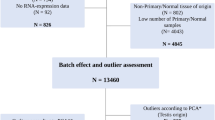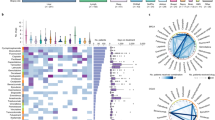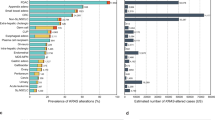Abstract
Pan-cancer genomic analyses based on the magnitude of pathway activity are currently lacking. Focusing on the cell cycle, we examined the DNA mutations and chromosome arm-level aneuploidy within tumours with low, intermediate and high cell-cycle activity in 9515 pan-cancer patients with 32 different tumour types. Boxplots showed that cell-cycle activity varied broadly across and within all cancers. TP53 and PIK3CA mutations were common in all cell cycle score (CCS) tertiles but with increasing frequency as cell-cycle activity levels increased (P < 0.001). Mutations in BRAF and gains in 16p were less frequent in CCS High tumours (P < 0.001). In Kaplan–Meier analysis, patients whose tumours were CCS Low had a longer Progression Free Interval (PFI) relative to Intermediate or High (P < 0.001) and this significance remained in multivariable analysis (CCS Intermediate: HR = 1.37; 95% CI 1.17–1.60, CCS High: 1.54; 1.29–1.84, CCS Low = Ref). These results demonstrate that whilst similar DNA alterations can be found at all cell-cycle activity levels, some notable exceptions exist. Moreover, independent prognostic information can be derived on a pan-cancer level from a simple measure of cell-cycle activity.
This is a preview of subscription content, access via your institution
Access options
Subscribe to this journal
Receive 50 print issues and online access
$259.00 per year
only $5.18 per issue
Buy this article
- Purchase on Springer Link
- Instant access to full article PDF
Prices may be subject to local taxes which are calculated during checkout



Similar content being viewed by others
Data availability
The data used in this study are publicly available on the NIH website (https://gdc.cancer.gov/about-data/publications/pancanatlas).
Code availablity
R-code to reproduce the main and Supplementary results of this study are publicly available at https://github.com/arianlundberg/PANCAN.analysis.
References
Hartwell LH, Culotti J, Pringle JR, Reid BJ. Genetic control of the cell division cycle in yeast. Science. 1974;183:46–51.
Nurse P, Thuriaux P, Nasmyth K. Genetic control of the cell division cycle in the fission yeast Schizosaccharomyces pombe. Mol Gen Genet MGG. 1976;146:167–78.
Lee MG, Nurse P. Complementation used to clone a human homologue of the fission yeast cell cycle control gene cdc2. Nature. 1987;327:31–5.
Evans T, Rosenthal ET, Youngblom J, Distel D, Hunt T. Cyclin: a protein specified by maternal mRNA in sea urchin eggs that is destroyed at each cleavage division. Cell. 1983;33:389–96.
Hartwell LH, Kastan MB. Cell cycle control and cancer. Science. 1994;266:1821–8.
Hanahan D, Weinberg RA. Hallmarks of cancer: the next generation. Cell. 2011;144:646–74.
Hoadley KA, Yau C, Wolf DM, Cherniack AD, Tamborero D, Ng S, et al. Multiplatform analysis of 12 cancer types reveals molecular classification within and across tissues of origin. Cell. 2014;158:929–44.
Bailey MH, Tokheim C, Porta-Pardo E, Sengupta S, Bertrand D, Weerasinghe A. et al. Comprehensive characterization of cancer driver genes and mutations. Cell. 2018;173:371–85.e18.
Taylor AM, Shih J, Ha G, Gao GF, Zhang X, Berger AC. et al. Genomic and functional approaches to understanding cancer aneuploidy. Cancer Cell. 2018;33:676–89.e3.
Sanchez-Vega F, Mina M, Armenia J, Chatila WK, Luna A, La KC. et al. Oncogenic signaling pathways in the cancer genome Atlas. Cell. 2018;173:321–37.e10.
Lundberg A, Lindström LS, Harrell JC, Falato C, Carlson JW, Wright PK, et al. Gene expression signatures and immunohistochemical subtypes add prognostic value to each other in breast cancer cohorts. Clin Cancer Res. 2017;23:7512–20.
Tobin NP, Lundberg A, Lindström LS, Harrell JC, Foukakis T, Carlsson L, et al. PAM50 provides prognostic information when applied to the lymph node metastases of advanced breast cancer patients. Clin Cancer Res. 2017;23:7225–31.
Chang F, Lee JT, Navolanic PM, Steelman LS, Shelton JG, Blalock WL, et al. Involvement of PI3K/Akt pathway in cell cycle progression, apoptosis, and neoplastic transformation: a target for cancer chemotherapy. Leukemia. 2003;17:590–603.
Chen J. The cell-cycle arrest and apoptotic functions of p53 in tumor initiation and progression. Cold Spring Harb Perspect Med. 2016;6:a026104.
Sotiriou C, Pusztai L. Gene-expression signatures in breast cancer. N. Engl J Med. 2009;360:790–800.
Kanehisa M, Sato Y, Kawashima M, Furumichi M, Tanabe M. KEGG as a reference resource for gene and protein annotation. Nucleic Acids Res. 2016;44:D457–62.
Santos A, Wernersson R, Jensen LJ. Cyclebase 3.0: a multi-organism database on cell-cycle regulation and phenotypes. Nucleic Acids Res. 2015;43:D1140–4.
Gray KA, Yates B, Seal RL, Wright MW, Bruford EA. Genenames.org: the HGNC resources in 2015. Nucleic Acids Res. 2015;43:D1079–85.
Liu J, Lichtenberg T, Hoadley KA, Poisson LM, Lazar AJ, Cherniack AD, et al. An integrated TCGA pan-cancer clinical data resource to drive high-quality survival outcome analytics. Cell. 2018;173:400–16.e11.
Turner NC, Liu Y, Zhu Z, Loi S, Colleoni M, Loibl S, et al. Cyclin E1 expression and palbociclib efficacy in previously treated hormone receptor-positive metastatic breast cancer. J Clin Oncol. 2019;37:1169–78.
Sparano JA, Gray RJ, Ravdin PM, Makower DF, Pritchard KI, Albain KS, et al. Clinical and genomic risk to guide the use of adjuvant therapy for breast cancer. N. Engl J Med. 2019;380:2395–405.
Desmedt C, Haibe-Kains B, Wirapati P, Buyse M, Larsimont D, Bontempi G, et al. Biological processes associated with breast cancer clinical outcome depend on the molecular subtypes. Clin Cancer Res. 2008;14:5158–65.
Asp M, Bergenstråhle J, Lundeberg J. Spatially resolved transcriptomes-next generation tools for tissue exploration. BioEssays. 2020;e1900221. https://onlinelibrary.wiley.com/doi/10.1002/bies.201900221.
Tobin NP, Lindström LS, Carlson JW, Bjöhle J, Bergh J, Wennmalm K. Multi-level gene expression signatures, but not binary, outperform Ki67 for the long term prognostication of breast cancer patients. Mol Oncol. 2014;8:741–52.
Hoadley KA, Yau C, Hinoue T, Wolf DM, Lazar AJ, Drill E, et al. Cell-of-Origin patterns dominate the molecular classification of 10,000 tumors from 33 types of cancer. Cell. 2018;173:291–304. e6.
Carter SL, Cibulskis K, Helman E, McKenna A, Shen H, Zack T, et al. Absolute quantification of somatic DNA alterations in human cancer. Nat Biotechnol. 2012;30:413–21.
R Development Core Team (2008). R: a language and environment for statistical computing. R Foundation for Statistical Computing, Vienna, Austria. ISBN 3-900051-07-0, URL http://www.R-project.org.
Funding
This work was supported by the Iris, Stig och Gerry Castenbäcks Stiftelse for cancer research (to NPT), the King Gustaf V Jubilee Foundation (NPT and JB), BRECT, the Swedish Cancer Society, the Cancer Society in Stockholm Personalised Cancer Medicine (PCM), the King Gustaf V Jubilee Foundation, the Swedish Breast Cancer Association (BRO) and the Swedish Research Council (J. Bergh). CMP was supported by funds from the NCI Breast SPORE program (P50-CA58223-09A1), by R01-CA195754-01, by the Susan G. Komen (SAC-160074) and the Breast Cancer Research Foundation.
Author information
Authors and Affiliations
Corresponding author
Ethics declarations
Conflict of interest
JB has no conflict of interest related to the present work. Unrelated to the present work, he received research funding from Merck paid to Karolinska Institutet and from Amgen, Bayer, Pfizer, Roche and Sanofi-Aventis paid to Karolinska University Hospital. No personal payments. Payment from UpToDate for a chapter in breast cancer prediction paid to Asklepios Medicine AB. CMP is an equity stockholder, and consultant, for of BioClassifier LLC. CMP and JP are also listed as inventors on patents on the Breast PAM50 Subtyping assay. All remaining authors have declared no conflicts of interest.
Additional information
Publisher’s note Springer Nature remains neutral with regard to jurisdictional claims in published maps and institutional affiliations.
Rights and permissions
About this article
Cite this article
Lundberg, A., Lindström, L.S., Parker, J.S. et al. A pan-cancer analysis of the frequency of DNA alterations across cell cycle activity levels. Oncogene 39, 5430–5440 (2020). https://doi.org/10.1038/s41388-020-1367-4
Received:
Revised:
Accepted:
Published:
Issue Date:
DOI: https://doi.org/10.1038/s41388-020-1367-4
This article is cited by
-
Dyskerin and telomerase RNA component are sex-differentially associated with outcomes and Sunitinib response in patients with clear cell renal cell carcinoma
Biology of Sex Differences (2023)
-
Heterogeneity of neuroendocrine transcriptional states in metastatic small cell lung cancers and patient-derived models
Nature Communications (2022)
-
Reclassifying tumour cell cycle activity in terms of its tissue of origin
npj Precision Oncology (2022)



